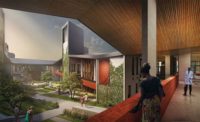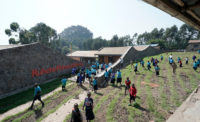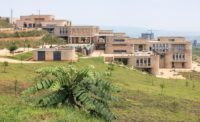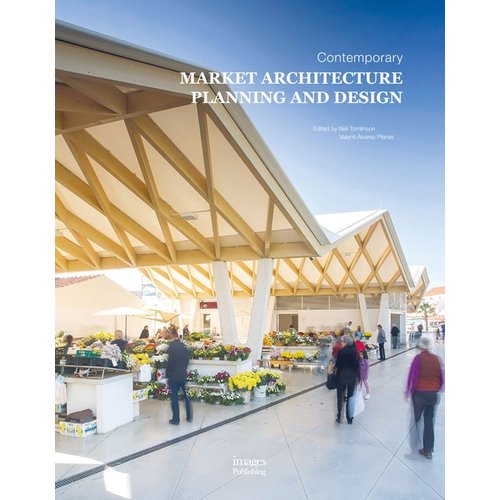MASS Design Group Establishes a Model for Regenerative Construction in Rwanda
The development is expected to be the world's first carbon-positive university

Architects & Firms
The opportunity to build an entire university campus from scratch, with a mandate to offer solutions to some of the world’s most critical problems, is a rare thing. But in the rapidly developing East African country of Rwanda, a conjunction of groundbreaking design, government support, and philanthropic commitment has led to the completion later this year of what’s expected to be the first carbon-positive university in the world: the 3,400-acre Rwanda Institute for Conservation Agriculture (RICA).
Underlying the carbon-positive achievement (pulling more greenhouse gases out of the atmosphere than the project’s construction and operation emit) is a way of working that MASS Design Group, the project’s architect, has been developing through its building in Rwanda and elsewhere for the last 15 years. Premised on the understanding that major capital projects represent an investment in a place and its community, and that each design decision offers an opportunity to optimize that investment, the campus exemplifies the holistic engagement with contextual materials and methods that is the hallmark of the firm’s work.

1
RICA's buildings rely on local materials, namely timber and earth, as seen in the structure housing the dining hall and offices (1 & 2). Photos © Iwan Baan, click to enlarge.

2
With RICA, conceived and funded by the Howard G. Buffett Foundation and supported by the Government of Rwanda, that paradigm has reached a new level of scale. Over 90 percent of the project’s $75 million budget was spent regionally, within 500 miles of the campus. Ninety-six percent of materials, by weight, were sourced within Rwanda. Three-quarters of the project’s labor costs stayed in the project’s district, and 94 percent remained in the country. More than 300 workers were trained in sustainable construction methods, 16 percent of whom were women. About 85 local artisans and cooperatives fabricated MASS-designed furniture and fittings—some 9,000 objects in all—which, by contrast with short-lived imported items (plastic chairs, that’s you), can now be maintained and repaired. The project has fostered local markets—for terra-cotta and timber, for example. And it has modeled new methods of working with regionally appropriate materials—methods that are now informing the development of new trade standards and practices regionally and internationally.

1
Local artisans and cooperatives collaborated with MASS to create RICA's furniture and fittings, such as the lighting fixtures (1) at the upper-year housing complex (2 & 3). Photos © Iwan Baan

2

3
“It’s in places that are poor or historically marginalized, or places that haven’t had as much access to resources, that we have to be aspirational,” Alan Ricks, a founding principal and chief design officer with MASS, told RECORD for the magazine’s recent climate-justice feature (June 2022). What he sees in Rwanda is a pursuit of progress that does not seek to emulate the Global North but instead leapfrogs existing systems and proposes contextually appropriate solutions. “For me as an American, this isn’t about imparting anything,” he says. “Rather, it’s a question of: What have we learned from the hunger for innovation and from the social and environmental concern that you see across sectors in Rwanda? How can what is happening in Rwanda set an example for what we should be aspiring to in the U.S. and elsewhere?”
Like many countries in the Global South, Rwanda is transforming rapidly. In the last 50 years, as its population has more than tripled, land use has shifted from more than three-quarters wilderness to more than three-quarters agricultural production, contributing to deforestation, overgrazing, soil degradation, and loss of habitat and biodiversity. About 80 percent of Rwandan households rely on farming for at least part of their livelihood, but a fifth are nonetheless food insecure. Already the most densely inhabited country in sub-Saharan Africa, with 13.6 million people in a nation hardly bigger than Vermont (population 625,000), Rwanda’s population is expected to double again by 2050.
Click drawing to enlarge

In this context of increasing urgency, RICA aims to reposition agriculture as a forward-looking interdisciplinary and entrepreneurial profession capable of attracting the country’s best young minds to a future in which nature and agriculture become symbiotic. “Developing a future of sustainable food is inherently about figuring out how to address the threats of climate change and biodiversity loss,” says Ricks. “So how does the architecture and the construction of the university embody those same principles?”
Located on the shore of Lake Kilimbi, southeast of the capital city of Kigali, RICA is approached via a MASS-designed road that prioritizes cyclists and pedestrians, with forage grasses for community harvest along the shoulders. The campus includes landscape, faculty and student housing, academic space, barns, storage, and agricultural processing facilities, all connected along an undulating, campus-long path set back from the lake. For the institute’s 250 students—all of whom receive full scholarships—instruction takes place in the classrooms and in the campus fields, with first-year students learning the principles of smallholder farming on five-acre model plots (a size that’s typical for a Rwandan farm), and second- and third-year students participating in enterprise-scale agribusinesses such as irrigated cropping systems and food-processing. There’s an emphasis on leadership and entrepreneurship throughout, and an extension program connects the institute to the community.

Learning takes place both in the field and in the classroom. Photo © Iwan Baan
Two complementary concepts inform both the curriculum and the design. “One Health,” which is gaining increasing recognition globally, holds that human, animal, and ecological health are inextricably intertwined. “Conservation Agriculture,” meanwhile—in contrast to the shortsighted practices of industrial farming that have proven so damaging—centers on the importance of soil conservation and regeneration, actively rebuilding biodiversity and natural processes above and below the surface of the ground.
“There are four steps to achieving radically carbon-positive landscapes,” says Sierra Bainbridge, a landscape architect and managing director in MASS’s Boston office. “You can apply at least one to any site anywhere, and if you do all of them—as RICA does—then you have the opportunity to make sure everything is going forward in balance.” The first step is to conserve intact landscapes. For RICA, the design process began with a deep site analysis: soil, water, slope, and species, among other factors. Based on an ecologist-generated map of what once lived here and what could live here, a long-range plan conserves the site’s ecologically rich savannah woodland; it’s one of very few intact remnants outside of the country’s national parks and a significant carbon sink for offsetting the development. The second step is to restore ecological functionality wherever possible, which RICA does by stitching the woodland back to the lake with new landscape corridors. Third, proliferate: boosting biodiversity, the project planted more than 300,000 plants propagated from plant material collected on-site. And, finally, sequester carbon through reforestation and plantings, pulling carbon dioxide from the atmosphere through photosynthesis and storing it long-term. Assuming the reforestation component of the project goes ahead within the next year or two, RICA’s 64-building, 100-acre campus (within the 3,400-acre site) is estimated to become carbon positive within six years.

The campus encompasses faculty housing (above) and student residences. Photo © Iwan Baan
A crucial aspect of the design that makes carbon-positive status possible is the use of low-embodied-energy construction materials and methods. (Embodied energy refers to the greenhouse-gas emissions that are generated during the extraction, manufacture, and transportation of building materials, and during construction and disposal.) As an allegory for the centrality of soil in Conservation Agriculture, the buildings’ main material is earth: stone for the foundations, rammed-earth blocks for the walls, and terra-cotta for the roof tiles. Finishes, such as plaster and tile, are also made of earth. With the roof structure consisting of sustainably managed regionally sourced timber, the only major components that the entirely off-grid campus brought from outside the region are its wastewater-treatment system and a 2,950-megawatt-hours-per-year solar array.
In addition to their strengths in terms of carbon and concept, earth and wood are also the materials that were most readily available in the region, ones whose supply chain could be understood. For a project prioritizing health, ecology, and ethical production, and using exploitation-free labor, “picking things out of catalogues would in some ways be more challenging,” Ricks says. “In the U.S., architects have more or less outsourced everything. But if we want to have agency, we need to start taking more responsibility for the process.”
Doing that at the scale of this project presented challenges. Timber, for example, was initially unavailable on the local market in the quantities and sizes RICA required. By working with foresters regionally, extending into neighboring Tanzania, the project team used the dimensions, lengths, and strengths of harvestable forest stands to inform the design of RICA’s roof systems, and was able to introduce new sizes of tested and graded lumber into the nascent timber market. RICA’s use of wood is also helping to rehabilitate a material that’s commonly regarded in the region as “not modern,” Ricks says.
Promoting the use of wood in a deforested country may seem counterintuitive, but in fact developing a market for sustainably managed forest products encourages the planting of endemic trees, such as the Markhamia lutea used in the project’s furniture. MASS’s research has shown that farmers can earn more over the lifetime of a tree by harvesting it for lumber instead of cutting it earlier for charcoal, the currently common practice—a concept that RICA’s curriculum is expected to include in the coming years.
Perhaps the biggest challenge in using earth at this scale—especially structurally—was a lack of regional precedents or even books for guidance, says Jean Paul Uzabakiriho, design director in MASS’s Rwanda office and site project manager for RICA. All of the earth for the blocks in the superstructure was quarried on-site, and yet, Uzabakiriho says, “it was hard to believe there could be so many different reactions and behaviors of soil from different pits.” So, rather than assuming “earth” is a singular material, he says, “every time you are trying a new natural material, testing—and recording and relying on the results—is the key.”
Solving problems through experimentation led to three major successes. As the first, “it empowered the community to make use of these materials, and it empowered the local team to feel part of the process and of the project’s bigger achievement,” Uzabakiriho says. At the start, many of the workers had little or no construction experience. They were dubious about the viability of these materials at this scale, and even the trade experts were skeptical. Uzabakiriho credits the turnaround to an authentic and comprehensive process of engagement. “Presenting the concept at the outset, and being honest about what we know and what we don’t, changed the way of thinking,” he says. “They were all basically encouraged and fighting to get that final product.” By the end, the novice masons, carpenters, and plasterers who had developed solutions through trial and error had become experts. “For someone doing construction for the first time, from scratch, using a new material, in the end to feel that they now have the skills that will shape their career and their future, that I would say is success number one,” Uzabakiriho says.
The second success from innovation with low-carbon materials is that RICA has already become a model in the region, the country, and even internationally. There have been many visits from members of regulatory bodies in various trades, Uzabakiriho says, and the project is being referred to by experts and technical authorities.
The third success Uzabakiriho identifies, from the perspective of construction administration, was the clarity and conviction that RICA’s original vision infused into an arduous process. “The main mission for the project was to minimize the carbon footprint of the whole process by using the natural materials that are most available,” he says. “We had so many trials, so many failures, and were sometimes overtime on the schedule because of the testing process. But because we had that mission, we ended up having the project that we wanted.” It’s a reminder, he says, that “every day and on every project, we should have that mission set from the beginning.”
Just as it’s unusual to build an entire university campus from scratch, so it’s unusual for the architect to have such a high degree of control over the process. “To understand what goes into our buildings—not just in terms of embodied carbon, but embodied costs, labor, and environmental impacts—these things are hard to do,” says Ricks. And, yet, worthwhile. “Our being involved and getting into the weeds made the project better,” says Chris Hardy, project architect for RICA, who has recently returned to MASS’s Boston office after four years in Kigali. “There’s comfort in being able to rely on standards and common practice, but, in emerging markets, you don’t have that luxury.” Instead, stepping out of that comfort zone, thinking critically about project goals, being willing not to rely on a catalogue, and returning to first principles are what helped RICA achieve climate positivity. “I’m looking forward to bringing some of that back with me,” Hardy says.
While design decisions and advocacy have the power to influence building materials’ supply-chain values and carbon impacts, to put the entire onus of doing right by the planet on architects is unrealistic, says Ricks: “We need regulatory, political, social, and market pressures to demand these things, so that the appropriate amount of research and development can go into figuring out the answers.”
In the meantime, RICA stands as a new precedent for what a radically contextual mode of practice can do—socially, materially, and ecologically. As Uzabakiriho says, “Even with photographs, it’s hard to describe the beauty and what the local community all together were able to achieve.”
Click drawing to enlarge

Click drawing to enlarge

Credits
Architect:
MASS Design Group – Alan Ricks, design lead; Kelly Alvarez Doran, project lead; Sierra Bainbridge, landscape design lead; Chris Hardy, project manager; Jean Paul Uzabakiriho, supervision lead; Rosie Goldrick, engineering lead; Christian Benimana, Noella Nibakuze, Anton Larson, Giovanni Bortolotti, Jean Paul Sebuhayi Uwase, Josh Greene, Taylor Klinkel, TJ Burghart, Rene Gasana, Martine Dushime, Kelly Umutoni, Lamy Subira, Amani Rwibasira, Genna Kalvaitis, Jean Luc Ntwali, Catherine Lie, Erinn McGurn, Aziz Farid Shyaka, Bethel Abate, Symphorien Gasana, Nicki Reckziegel, Jamie Wiberg, Kristen Henderson, Deb Rosenberg, Anibal Niyitanga, Alba Mukundwa Karenzi, Adam Saltzman, Ines Uwimbabazi, Nadia Perlepe, Giorgio Azzariti, architecture & implementation; Jessi Flynn, Therese Graf, Jonathan Blaseg, Greg Dahlke, Patrice Uwizeyimana, Taylor Sinclair, Melissa Flatley, landscape architecture & implementation
Consultants:
MASS Design Group
(s/m/e/p); Arup (civil); Transsolar (environmental); Curry Willey Associates (agricultural); Conspectus (specifications)
General Contractors:
MASS Build, Costwise Contractors, Remote Group
Owner:
Rwanda Institute for Conservation Agriculture
Size:
3,400 acres
Cost:
$75 million
Expected Completion Date:
September 2022
Sources
Tile:
Ruliba Products
Timber:
New Forest Company, Sao HIll Industries/Green Resources, Tekwani
Furnishings:
Designed and manufactured in Rwanda by MASS Design Group in collaboration with local artisans and cooperatives
Continuing Education

To earn one AIA learning unit (LU), including one hour of health, safety, and welfare (HSW) credit, read the article above, and Gernot Minke. “Introduction.” Building with Earth: Design and Technology of a Sustainable Architecture, Birkhauser, 2006, pp. 11-18.
Then complete the quiz. Upon passing the test, you will receive a certificate of completion, and your credit will be automatically reported to the AIA. Additional information regarding credit-reporting and continuing-education requirements can be found at continuingeducation.bnpmedia.com.
Learning Objectives
- Outline the steps involved in creating carbon-positive landscapes.
- Explain the concepts "One Health" and "Conservation Agriculture."
- Describe how the RICA project helped establish supply chains and markets for locally produced, regionally appropriate low-carbon materials.
- Discuss shifts in land use in Rwanda over the past several decades and the resulting environmental problems.
AIA/CES Course #K2208A







